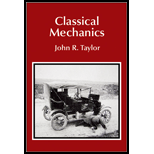
The velocity of mass
Answer to Problem 15.84P
The velocity of mass
Explanation of Solution
Write the expression for the momentum of a particle having mass
Here,
Write the expression for the relativistic momentum of the mass.
Here,
Write the expression for the relativistic total energy.
Write the general expression for the relativistic energy.
Write the expression for
Use equation (IV) and (V) in (III) to solve for
It is provided that the particle has initial three momentum as
Write the expression for the relativistic momentum.
Write the general expression for the relativistic momentum.
Here,
Use equation (VIII) and (VI) in (VII) to solve for
Consider
Write the expression for the trajectory of the particle.
Here,
Use equation (X) in (XI) to solve for
Here,
Use
Applying the boundary conditions
Use equation (XIV) in (XIII) to solve for
The constant force
Write the expression for the displacement along the
Write the expression for the displacement along the
Replace
Use equation (XVII) to solve for
Use equation (XVIII) in (XVI) to solve for
If the motion of the mass is considered as non-relativistic, then use the condition
Integrate the equation (XIX) to solve for
Apply the boundary conditions in equation (XXI) to solve for
Use equation (XXII) to solve for the displacement along the
Use equation (XXIII) to solve for
Use equation (XXIV) to solve for the displacement along the
The trajectory of the particle in the case of non-relativistic motion is parabola.
Conclusion:
Therefore, the velocity of mass
Want to see more full solutions like this?
Chapter 15 Solutions
Classical Mechanics
 College PhysicsPhysicsISBN:9781305952300Author:Raymond A. Serway, Chris VuillePublisher:Cengage Learning
College PhysicsPhysicsISBN:9781305952300Author:Raymond A. Serway, Chris VuillePublisher:Cengage Learning University Physics (14th Edition)PhysicsISBN:9780133969290Author:Hugh D. Young, Roger A. FreedmanPublisher:PEARSON
University Physics (14th Edition)PhysicsISBN:9780133969290Author:Hugh D. Young, Roger A. FreedmanPublisher:PEARSON Introduction To Quantum MechanicsPhysicsISBN:9781107189638Author:Griffiths, David J., Schroeter, Darrell F.Publisher:Cambridge University Press
Introduction To Quantum MechanicsPhysicsISBN:9781107189638Author:Griffiths, David J., Schroeter, Darrell F.Publisher:Cambridge University Press Physics for Scientists and EngineersPhysicsISBN:9781337553278Author:Raymond A. Serway, John W. JewettPublisher:Cengage Learning
Physics for Scientists and EngineersPhysicsISBN:9781337553278Author:Raymond A. Serway, John W. JewettPublisher:Cengage Learning Lecture- Tutorials for Introductory AstronomyPhysicsISBN:9780321820464Author:Edward E. Prather, Tim P. Slater, Jeff P. Adams, Gina BrissendenPublisher:Addison-Wesley
Lecture- Tutorials for Introductory AstronomyPhysicsISBN:9780321820464Author:Edward E. Prather, Tim P. Slater, Jeff P. Adams, Gina BrissendenPublisher:Addison-Wesley College Physics: A Strategic Approach (4th Editio...PhysicsISBN:9780134609034Author:Randall D. Knight (Professor Emeritus), Brian Jones, Stuart FieldPublisher:PEARSON
College Physics: A Strategic Approach (4th Editio...PhysicsISBN:9780134609034Author:Randall D. Knight (Professor Emeritus), Brian Jones, Stuart FieldPublisher:PEARSON





